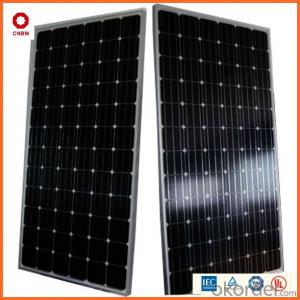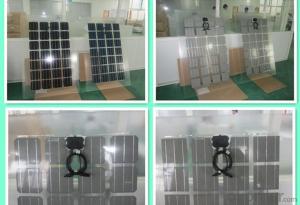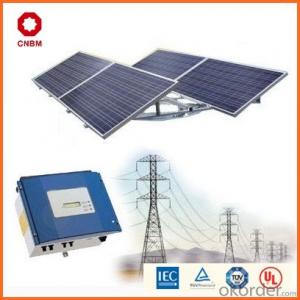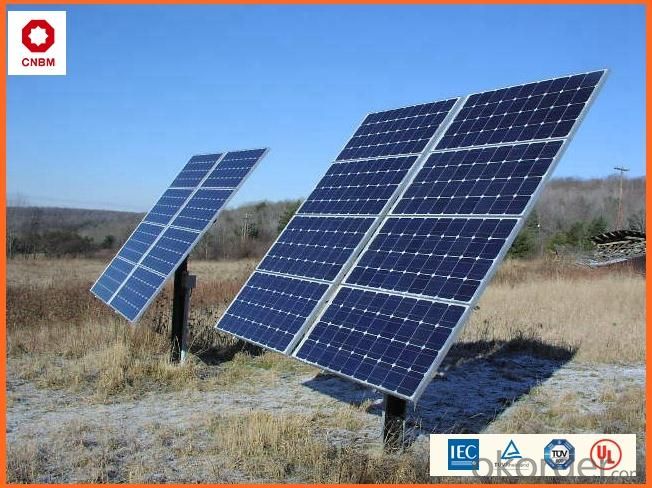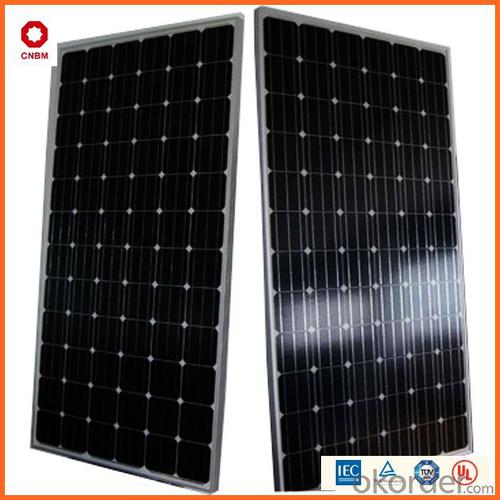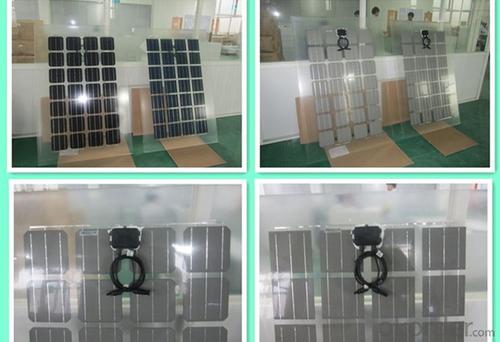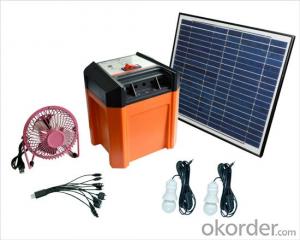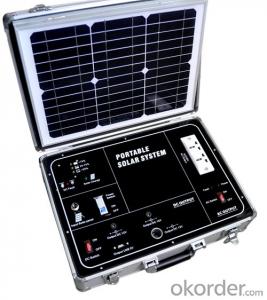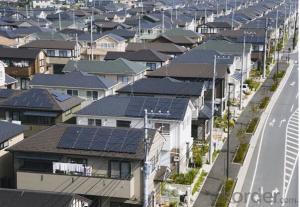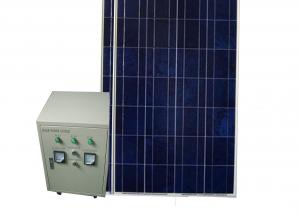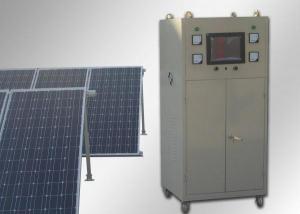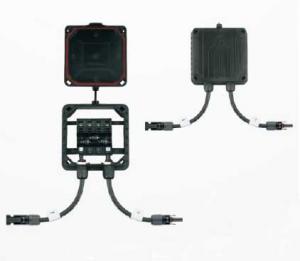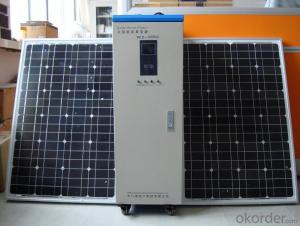90w Small Solar Panels for Home Solar Energy Systems - In Stock China Manufacturer
- Loading Port:
- China main port
- Payment Terms:
- TT OR LC
- Min Order Qty:
- 1 watt
- Supply Capability:
- 10000000 watt/month
OKorder Service Pledge
OKorder Financial Service
You Might Also Like
Specification
Product Description:
Hot Sale !!! Quality and Safety of Small Poly Solar Panel 5w~150w
1. Rigorous quality control meets the highest international standards.
2. High-transmissivity low-iron tempered glass, strong aluminium frame.
3. Using UV-resistant silicon.
4. IS09001/14001/CE/TUV/UL
Warranties of Small Poly Solar Panel 35~85w
1. 10 years limited product warranty
2. 15 years at 90% of the minimal rated power output
3. 25 years at 80% of the minimal rated power output
Specification
Characteristics of Poly solar panels CNBM (245-320W) | |||||
Max Power Voltage Vmp(V) | 30.3 | 30.8 | 31.1 | 31.4 | 31.85 |
Max Power Current Imp(A) | 7.60 | 7.64 | 7.73 | 7.81 | 7.85 |
Open Circuit Voltage Voc(V) | 36.1 | 36.6 | 37 | 37.3 | 37.68 |
Short Circuit Current Isc(A) | 8.50 | 8.55 | 8.65 | 8.75 | 8.85 |
Max Power Pm(W) | 230W | 235W | 240W | 245W | 250W |
Temperature Coefficient of Cells Poly solar panels CNBM (245-320W) | |
NOCT | 45± 2 |
Temperature Coeffucients of Isc | 0.0492 |
Temperature Coeffucients of Voc | -0.3374 |
Temperature Coeffucients of Voc | -0.4677 |
Mechanical Data of Poly solar panels CNBM (245-320W) | |
Dimension | 1638 × 982 × 40 mm |
Weight | 19.5 kg |
No. of Cells and Connections | 60 (6 ×10) |
Tolerance | 0 ~ + 5 W |
Cell | Monocrystalline Cell 156 × 156 mm |
Packing | 624 Pcs/40ft(H) Container |
Limits of Poly solar panels CNBM (245-320W) | |
Operating Temperature | -40 to +85 |
Storage Temperature | -40 to +85 |
Max System Voltage | 1000VDC(IEC) / 600VDC(UL) |
Features of our products:
• High conversion efficiency mono/poly-crystalline amorphous silicon solar cells
• Modules incorporate high performance bypass diodes to minimize the power drop caused by shading
• High transmittance, low-iron tempered glass
• High performance EVA encapsulant to prevent destroying and water.
• AI frame: without screw, corner connection. 8 holes on the frame can be installed easily
• Good performance of preventing from atrocious weather such as wind and hails
• Certifications: CE IEC TUV VDE UL, Class I
• 10 years 90% power output warranty

Shipping of Small Poly Solar Panel 35~85w
By Sea | Delivery from Shanghai or Ningbo seaport |
By Air | Departure from Shanghai Pudong Airport |
By Express | Post by DHL, EMS, UPS, TNT. |
Features of our products:
• High conversion efficiency mono/poly-crystalline amorphous silicon solar cells
• Modules incorporate high performance bypass diodes to minimize the power drop caused by shading
• High transmittance, low-iron tempered glass
• High performance EVA encapsulant to prevent destroying and water.
• AI frame: without screw, corner connection. 8 holes on the frame can be installed easily
• Good performance of preventing from atrocious weather such as wind and hails
• Certifications: CE IEC TUV VDE UL, Class I
• 10 years 90% power output warranty
As a professional Solar Panel manufacturer and Supplier in China, we have our customers come around the whole world and our specialization has got a worldwide recognition. Meanwhile, with our superior quality, competitive price, prompt and excellent service, As main role in trade section of CNBM Group, CNBM International Corporation supplies products including Monocrystalline Solar Panel, Polycrystalline Solar Panel ( multicrystalline silicon Solar Panel) have received and enjoyed famous reputation in many countries and regions in the world.
- Q: How does a PV system convert sunlight into electricity?
- A PV (photovoltaic) system converts sunlight into electricity through the use of solar panels. These panels contain photovoltaic cells made of semiconducting materials, such as silicon. When sunlight hits these cells, it excites the electrons, causing them to flow and create an electric current. This direct current (DC) is then converted into alternating current (AC) using an inverter, which can be used to power homes, businesses, or other electrical devices.
- Q: What is the impact of tree shade on the performance of solar panels?
- The performance of solar panels can be greatly affected by the presence of tree shade. When trees cast shadows on solar panels, their ability to convert sunlight into electricity is significantly diminished. This occurs because the shade prevents direct sunlight from reaching the panels, resulting in a decrease in overall efficiency. Shade on solar panels gives rise to a phenomenon called "partial shading," where only a portion of the panel is shaded. In such cases, the shaded section acts as an obstacle, limiting the unshaded portion from producing electricity at its full potential. Consequently, the solar panel system experiences a decline in energy production. Furthermore, tree shade can cause an imbalance in the output of solar panels that are connected in series. When one panel is shaded, it becomes a bottleneck for the flow of electricity, leading to a significant decrease in the performance of the entire series. As a result, the overall energy generation of the solar system is compromised. It is important to note that the impact of tree shade on solar panels varies depending on various factors, such as the intensity and duration of the shade, the orientation and tilt angle of the panels, and the efficiency of the panels themselves. Additionally, advancements in solar panel technology, such as the use of bypass diodes in modern systems, can help alleviate the negative effects of shading to a certain extent. To optimize the performance of solar panels in the presence of tree shade, careful consideration must be given to the placement and design of the solar panel system. This may involve actions like trimming or removing trees that cast shade on the panels, adjusting the tilt angle of the panels to minimize shading, or exploring alternative installation locations where shade is less of a concern. In conclusion, tree shade can significantly impact the performance of solar panels by reducing their efficiency and energy production. Therefore, it is crucial to thoroughly evaluate the effects of shade when planning and designing a solar panel installation to maximize its effectiveness.
- Q: Can solar energy systems be used for waste management?
- Yes, solar energy systems can be used for waste management. Solar energy can power various waste management processes such as waste-to-energy conversion, landfill gas extraction, and waste water treatment. By utilizing solar power, these systems can reduce reliance on traditional energy sources, lower carbon emissions, and contribute to a more sustainable waste management approach.
- Q: What is the environmental impact of solar energy systems?
- Solar energy systems have a significantly positive environmental impact. They generate electricity without emitting greenhouse gases or harmful pollutants, reducing air pollution and combating climate change. Additionally, solar energy systems require minimal water usage compared to fossil fuel-based power plants, minimizing strain on water resources. This renewable energy source also helps conserve natural resources and reduces our reliance on finite fossil fuel reserves. Overall, solar energy systems contribute to a cleaner and more sustainable environment.
- Q: What is the role of solar panel cleaning in maintaining optimal performance?
- Solar panel cleaning plays a crucial role in maintaining optimal performance by removing dirt, dust, bird droppings, and other debris that can accumulate on the surface of the panels. These contaminants can significantly reduce the panel's ability to absorb sunlight and convert it into electricity. Regular cleaning ensures maximum sunlight absorption, increasing the efficiency and output of the solar panels.
- Q: Can solar energy systems be used in areas with high levels of dust or debris?
- Yes, solar energy systems can be used in areas with high levels of dust or debris. However, regular maintenance and cleaning may be required to ensure optimal performance of the solar panels.
- Q: How do solar energy systems impact water resources?
- Solar energy systems have a positive impact on water resources as they do not require water for their operation, unlike traditional energy sources such as coal or nuclear power plants. This helps in conserving water, which is a precious resource, and reduces the strain on water supplies. Additionally, solar energy systems can be utilized to power water treatment plants, enhancing access to clean and safe water in remote areas.
- Q: Can a solar energy system be installed in areas with frequent lightning strikes?
- It is indeed possible to install a solar energy system in areas prone to frequent lightning strikes, but certain precautions must be taken to ensure its safety. Failure to do so could result in potential damage to solar panels, inverters, and other system components. To reduce the risk, several strategies can be implemented. The installation of a lightning protection system (LPS), which incorporates lightning rods, grounding systems, and surge protection devices, is highly recommended. These systems are designed to divert lightning strikes away from the solar panels and safely dissipate the electrical energy into the ground. Additionally, the use of high-quality surge protectors and lightning arrestors in electrical and communication lines can protect the system from power surges caused by lightning strikes. Furthermore, it is crucial to select durable and robust solar panels and inverters that meet industry standards for lightning protection. Some manufacturers offer products specifically designed to withstand severe weather conditions, including lightning strikes. Regular maintenance and inspections are also essential to ensure the continued safety and functionality of the system. This includes checking the integrity of the lightning protection system and inspecting the solar panels and other components for signs of damage or wear. In conclusion, while it is feasible to install a solar energy system in areas with frequent lightning strikes, it is essential to implement proper precautions and protective measures. Collaborating with experienced solar installers who possess knowledge about lightning protection systems can guarantee the secure and efficient operation of the solar energy system, even in high-risk areas.
- Q: Can solar energy systems be installed in areas with high snowfall?
- Yes, solar energy systems can be installed in areas with high snowfall. However, it is important to consider the impact of snow accumulation on the efficiency and performance of these systems. Proper design and installation techniques can help minimize the impact of snow on solar panels, such as tilted mounting angles, snow guards, and regular snow removal. Additionally, advancements in technology have led to the development of snow-shedding coatings and self-cleaning systems that can further enhance the productivity of solar energy systems in snowy regions.
- Q: Can solar energy systems be used for powering off-grid eco-lodges?
- Yes, solar energy systems can be effectively used for powering off-grid eco-lodges. Solar panels can be installed on the roofs of eco-lodges to harness the energy from the sun and convert it into electricity. This renewable source of energy can then be used to power various electrical appliances, lighting, heating, and cooling systems in the eco-lodges. Additionally, solar energy systems can also incorporate battery storage to store excess energy for use during cloudy or nighttime conditions. This sustainable solution not only reduces the reliance on fossil fuels but also minimizes the environmental impact of off-grid accommodations.
Send your message to us
90w Small Solar Panels for Home Solar Energy Systems - In Stock China Manufacturer
- Loading Port:
- China main port
- Payment Terms:
- TT OR LC
- Min Order Qty:
- 1 watt
- Supply Capability:
- 10000000 watt/month
OKorder Service Pledge
OKorder Financial Service
Similar products
Hot products
Hot Searches
Related keywords

